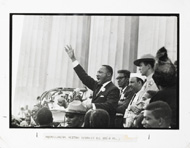 |
||
Photojournalism Overview
This curriculum is linked to two exhibitions of 20th-century news photography held at the J. Paul Getty Museum in the fall of 2005. The first, Scene of the Crime: Photo by Weegee looks at the career of Arthur Fellig (1899–1968), better known as Weegee (after the Ouija board game), who seemed to appear with camera in hand moments after a crime took place. The second, Pictures for the Press, examines images of World War II and Vietnam, and scenes closer to home of John F. Kennedy and the Civil Rights movement. These photographs provided visual accounts to millions of Americans in newspapers and magazines from the end of World War II and through the events that shaped the Cold War.
Modern photojournalism became possible after small-format cameras, developed in the second decade of the 20th century, became widely available around 1925. These small cameras were more portable and maneuverable than earlier models, which could be as large as a small hat box. The smaller size allowed photographers to get closer to an event and capture it as it unfolded.
The images in these teaching materials predate the widespread use of digital photography and satellite transmission. At the time these images were made, wirephoto technology was in its heyday, and television had not yet superceded the printed page as the medium through which most Americans got their news. In 1935 the Associated Press (AP) launched its Wirephoto network, allowing the delivery of news images over telephone lines. This new system, and the others that followed, allowed pictures to be published around the nation and the world with greater ease and speed than ever before. The use of these images was widespread, so readers from across the country were seeing the same images in their local and regional press. These photos were meant to capture attention and entice the reader to learn more, as well as to boost newspaper and magazine sales.
The printed page held dominance until the 1960s when television became the major news source for most Americans. With the assassination of John F. Kennedy on November 22, 1963, television established its popularity over all other news sources. Although the motion images taken by Abraham Zapruder and others on that day would not be shown to the public for over a decade, it is estimated that 170 million viewers turned to the television to watch as events unfolded in the aftermath of the assassination. Even though television has become our main source for the news and visual images, photographers continue to capture with the camera singular moments of newsworthy events that continue to shape our lives today.
Questions for Teaching
The following questions will help students think about issues while talking about, and looking at, documentary photography or photojournalism:
1. Look at how the image is cropped or "framed." What is included in the picture? Can you tell if anything was left out? How does the way the image is framed affect or influence our understanding of the event being represented?
2. Documentary photography/photojournalism seems to be a direct record of actual events, but in fact these images reflect an interpreted reality governed by logistical, aesthetic, and sometimes political choices. How is what the photographer leaves out of the image just as important as what he or she captures?
3. Is this photograph an "objective," neutral document of its subject? Is it ever possible to take a completely objective picture?
4. Is this photograph a "candid" shot, or was it staged by the photographer? How can you tell the difference? If the picture looks candid, might it nonetheless have been staged?
5. Do you think this image was made for documentary or artistic purposes? Why? What is the balance between artistry and documentation? List the things you see that make the image look documentary and then list the things that make it look artistic. What is the balance between the two? Is it important for a photograph to be both?
6. Discuss how image and story work together in newspapers and magazines. What can a visual image communicate that a written story cannot? What can a story communicate that a visual image cannot?